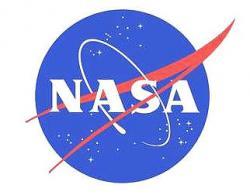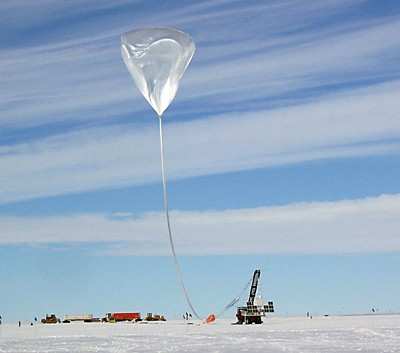 NASA and the National Science
Foundation have achieved a new milestone in conducting scientific
observations from balloons, by launching and operating three
long-duration flights within a single Antarctic summer.
NASA and the National Science
Foundation have achieved a new milestone in conducting scientific
observations from balloons, by launching and operating three
long-duration flights within a single Antarctic summer.
"Having three long-duration balloon science missions flying
simultaneously is a record-setting event. But of greater
significance is the increase in science that can be accomplished
with only a modest increase in cost to the program," said David
Gregory, assistant chief of NASA's Balloon Program at Wallops
Flight Facility in Virginia.
Unique atmospheric circulation over Antarctica during its summer
months allows scientists to launch balloons from a site near
McMurdo Station, the Foundation's logistics hub in Antarctica, and
recover them from nearly the same spot weeks later. During that
time, each balloon circles the continent one to three times.
Scientists from the United States, Japan, South Korea, France and
other countries are using the balloons to investigate the nature of
ultra-high-energy cosmic rays and to search for antimatter.
The three payloads will ride the stratospheric winds in the
polar vortex, a persistent low-pressure system above the Antarctic
continent that will help keep balloons aloft for up to six weeks.
This orbital pattern allows for long and continuous observations of
a variety of phenomena from a single instrument at a fraction of
the cost of launching a satellite into space.
The payloads launched Dec. 19 - 26 from McMurdo are the
University of Maryland's Cosmic Ray Energetics And Mass (CREAM)
experiment, the Balloon borne Experiment with a Superconducting
Spectrometer (BESS) developed by NASA's Goddard Space Flight
Center, Greenbelt, Md. and Japan's High Energy Accelerator Center,
Tsukuba, Japan, and Louisiana State University's Advanced Thin
Ionization Calorimeter (ATIC).
The CREAM investigation will search for characteristic changes
in elemental composition and energy spectra of very high-energy
cosmic rays that might be associated with a particle acceleration
limit in supernovae. ATIC is focusing on cosmic rays electrons,
which are of particular interest because they are subject to
synchrotron energy loses, so structure in their spectrum may be
linked to individual, nearby sources. BESS will provide definitive
measurements of low-energy antiprotons in solar minimum conditions,
with precise data that will constrain models for dark matter, in
addition to placing limits on decay of primordial black holes and
cosmological antimatter.

Once the balloon flights are completed, the payloads will be
retrieved, brought back to McMurdo, and then returned to the U.S.,
where they can be refurbished and launched again.
National Science Foundation (NSF) and NASA conduct an annual
scientific-balloon campaign during the Antarctic summer. NSF
manages the U.S. Antarctic Program and provides logistic support
for all U.S. scientific operations in Antarctica. The Foundation
facilitated the launches and will recover the payloads. NASA
communication satellites help scientists collect data from the
balloon experiments.
Antarctic balloon flights can last much longer than flights in
other places because of the polar vortex and because there is very
little atmospheric or temperature change. Constant daylight in
Antarctica means no day-to-night temperature fluctuations on the
balloon, which helps it stay at a nearly constant altitude during
the flight.
"We are extremely proud of our launch crew in Antarctica," said
W. Vernon Jones, senior scientists for suborbital research at NASA
Headquarters, Washington. "Continuous operations support for three
balloons in the air at one time, using the finest balloon vehicle
made for this kind of cutting-edge scientific research, led to this
major achievement," he added.
"If all three of these missions achieve their flight goals, this
Antarctic campaign will result in almost 90 days of near-space
flight at an average altitude of 23 miles, with experiments
averaging more than 4,300 pounds," Jones said.
"This annual scientific balloon expedition demonstrates the deep
commitment and very fruitful collaboration between NASA and the NSF
that enables a wide variety of forefront scientific research in
Antarctica," said Karl Erb, director of the Office of Polar
Programs.
 "Just as NSF provided the
infrastructure and logistics support that made this hat trick
possible, NASA provides the satellite communications link that is
the lifeblood of astrophysics research at our new research station
at the South Pole. Our partnership benefits both agencies and more
importantly, the U.S. science community," he said.
"Just as NSF provided the
infrastructure and logistics support that made this hat trick
possible, NASA provides the satellite communications link that is
the lifeblood of astrophysics research at our new research station
at the South Pole. Our partnership benefits both agencies and more
importantly, the U.S. science community," he said.
"Demanding science and excellent atmospheric conditions over the
Antarctica in the austral summer led our two agencies to sign an
agreement in 2003 aimed at increasing the launch tempo from one or
two to three balloons per season. With modest investments but
considerable effort by both agencies, this goal is now achieved" he
added.
Supporting the three science teams, the staff from NASA's
Columbia Scientific Balloon Facility (CSBC), Palestine, Texas,
traveled to Antarctica to launch the giant helium balloons.
"With the launch of the third balloon, we put 32,000 pounds of
hardware, including 13,000 pounds of science instruments, into near
space in a span of just over a week. It's a magnificent
accomplishment." said Danny Ball, site manager for New Mexico State
University the operator of the CSBF for NASA. "We're extremely
proud of our personnel who worked through Thanksgiving, Christmas,
and New Years in harsh conditions in Antarctica to make this
possible."
 A Crazy Tesla Flying Car is Coming
A Crazy Tesla Flying Car is Coming ANN's Daily Aero-Term (11.xx.25): NonApproach Control Tower
ANN's Daily Aero-Term (11.xx.25): NonApproach Control Tower Aero-News: Quote of the Day (11.01.25)
Aero-News: Quote of the Day (11.01.25) ANN's Daily Aero-Linx (11.01.25)
ANN's Daily Aero-Linx (11.01.25) Classic Aero-TV: EAA Introduces Angle of Attack Training
Classic Aero-TV: EAA Introduces Angle of Attack Training





